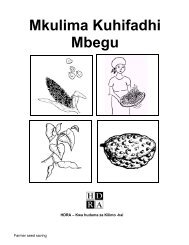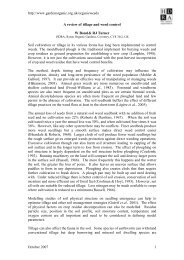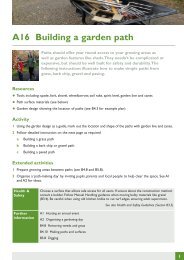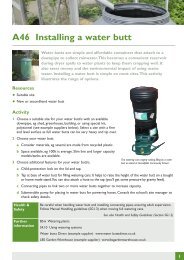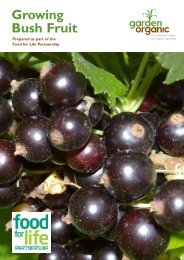A38 Making potting mixes - Garden Organic
A38 Making potting mixes - Garden Organic
A38 Making potting mixes - Garden Organic
Create successful ePaper yourself
Turn your PDF publications into a flip-book with our unique Google optimized e-Paper software.
<strong>A38</strong> <strong>Making</strong> <strong>potting</strong> <strong>mixes</strong><br />
Resources<br />
•<br />
•<br />
Materials for <strong>potting</strong> <strong>mixes</strong>. Most are readily available (see next page).<br />
Pots, trays and containers, with appropriate plants, eg, herbs, vegetables,<br />
fruit trees and attractant flowering plants.<br />
Activity<br />
1 Use the instructions on the next page. Select a <strong>potting</strong> mix recipe that<br />
suits the plant’s needs.<br />
2 Prepare the necessary quantities of materials. One of the perks of making<br />
your own <strong>mixes</strong> is blending just the right quantities. It’s generally best not<br />
to store homemade <strong>mixes</strong> as quality can decline.<br />
3 Mix your materials thoroughly on a hard surface at a convenient height<br />
or on the ground for larger quantities. Use your hands, or a shovel for larger quantities. Materials should<br />
be slightly damp, but not wet.<br />
4 Try out small quantities at first and monitor plant growth carefully.<br />
Extended activity<br />
Find out why organic gardeners don’t use peat based <strong>potting</strong> <strong>mixes</strong>. What are the exceptions and<br />
alternatives? Tip: see the <strong>Organic</strong> <strong>Garden</strong>ing Guidelines on the DVD.<br />
Health &<br />
Safety<br />
Further<br />
information<br />
Plants in pots and containers need special <strong>potting</strong> <strong>mixes</strong> to grow<br />
well. Soil on its own isn’t enough as the small volume available is<br />
unable to provide the benefits it does to outdoor plants, such as<br />
disease suppression, balanced nutrient levels, etc. A <strong>potting</strong> mix<br />
takes over these roles by blending different materials. The main<br />
types are reviewed in this activity, together with useful recipes.<br />
Potting mix ingredients are safe to handle if the usual garden hygiene rules are followed. Keep<br />
cuts covered, wash hands and keep your tetanus vaccination up to date. Follow Manual Handling<br />
guidelines (SG1.3) when moving heavy loads. If using mechanical processes or equipment, eg<br />
loam pasteurisation, observe manufacturers’ Health & Safety Advice and Guidelines on their use,<br />
particularly where heat is generated or electric power used.<br />
S4.2 Using compost<br />
<strong>Organic</strong> <strong>Garden</strong>ing Guidelines (see DVD)<br />
Top tip<br />
Keep experimenting<br />
J<br />
Getting <strong>potting</strong> <strong>mixes</strong> just<br />
right can be difficult and<br />
results variable. Manufacturers<br />
spend years getting<br />
commercial products right,<br />
while head gardeners are<br />
famous for keeping their<br />
recipes a close secret. The<br />
trick is to start by making<br />
simple recipes and work up<br />
from there.<br />
See also Health and Safety Guidelines (Section SG1.2)<br />
1
2<br />
Instructions for making <strong>potting</strong> <strong>mixes</strong><br />
Example recipes<br />
Note: The following recipes are mixed by VOLUME, not by weight, so you can use anything from a bucket to<br />
wheelbarrow to measure how much of each material you need, eg equal parts leafmould and loam.<br />
Seed sowing<br />
Requirements Seeds contain their own nutrients to get going so<br />
germinate successfully in low nutrient material.<br />
Seedlings need <strong>potting</strong> on as they start growing.<br />
Easy mix<br />
Good basic<br />
mix<br />
Leafmould, two years old.<br />
One part loam; sieved and ‘pasteurised’ (see Top tip<br />
page 6).<br />
One part leafmould, composted bark, or coir.<br />
One part sharp sand or vermiculite.<br />
Use See A18 and 19 about sowing seeds.<br />
Potting on<br />
Requirements Transplants need more nutrients than seedlings to<br />
keep growing strongly, but must also grow sturdily, so<br />
don’t need excessive nutrients.<br />
Good basic<br />
mix<br />
High nutrient<br />
mix<br />
One part loam.<br />
One part leafmould.<br />
One part home-made compost.<br />
One part worm compost or sieved, well rotted manure<br />
Three parts leafmould, composted bark or coir.<br />
Use See A21 about <strong>potting</strong> on.<br />
Cuttings<br />
Requirements Very good drainage so cuttings don’t rot, plus some<br />
nutrients for early growth.<br />
Mix One part home-made compost, leafmould,<br />
composted bark or coir.<br />
One part horticultural grit, sharp sand,<br />
or vermiculite.<br />
Use See A58 about taking cuttings.<br />
Herbs that need free draining mix<br />
Requirements Good drainage so plants don’t rot, eg those from<br />
Mediterranean regions, such as sage.<br />
Mix One part loam (sieved if needed, not ‘pasteurised’).<br />
One part home-made compost, leafmould or<br />
composted bark.<br />
One part horticultural grit, sharp sand, or vermiculite.<br />
Use See S3.5 for other examples of herbs.
Large containers<br />
Requirements Plants growing for a long time in the same container,<br />
eg fruit trees and bushes, need a good balance of<br />
slow-release nutrients.<br />
Good basic<br />
mix<br />
One part loam (sieved if needed, not pasteurised).<br />
One part home-made compost (substitute manure<br />
for compost for higher nutrients).<br />
Add general organic fertilisers (see<br />
manufacturers’ instructions).<br />
Use See A11 about <strong>potting</strong> up containers.<br />
Top tip<br />
The ideal mix should<br />
Provide the correct nutrients for the plant.<br />
Retain moisture, but drain well.<br />
Retain air, yet hold plant roots firmly.<br />
Be uniform in consistency, eg no large lumps, etc.<br />
Be free from pest, disease and weed seeds.<br />
The ideal mix should not<br />
Reduce in volume, leaving pots, trays and containers half empty.<br />
‘Slump’, becoming compact and airless.<br />
Become drained of nutrients very quickly or be too rich for<br />
young seedlings.<br />
Main components of <strong>potting</strong> <strong>mixes</strong><br />
J<br />
Loam<br />
Uses Seed sowing, <strong>potting</strong> on, larger containers.<br />
Source • Good quality garden soil. See A9 for example.<br />
• Buy bags from garden centres.<br />
• Make your own from rotting down grass turf. See<br />
A14 for technique.<br />
Purpose Bulk, nutrients, excellent buffer for slight nutrient<br />
imbalances, adds weight to help stop top heavy and<br />
taller plants toppling over, good moisture retention.<br />
Conditions Sieve before use. May contain weed seeds. Pasteurise<br />
before using for seed sowing and seedlings (see Top tip<br />
page 6).<br />
Sieving components for <strong>potting</strong> <strong>mixes</strong>, eg homemade<br />
compost, well rotted manure, etc.<br />
3
4<br />
Leafmould<br />
Uses Seed sowing, <strong>potting</strong> on, larger containers.<br />
Source Decomposed deciduous leaves. See A40 for<br />
technique. Suitable for <strong>potting</strong> <strong>mixes</strong> after two years.<br />
Use composted bark as substitute if leafmould not<br />
available.<br />
Purpose Bulk, low in nutrients, rich in micro-organisms helpful<br />
in suppressing diseases.<br />
Conditions May contain weed seeds and slug eggs.<br />
Composted bark<br />
Uses Seed sowing, <strong>potting</strong> on, larger containers.<br />
Source Made from decomposed bark. Buy in bags from<br />
garden centres.<br />
Purpose Bulk that retains air well, low in nutrients, rich in microorganisms<br />
helpful in suppressing diseases.<br />
Conditions May contain weed seeds. Sieve before use as can be<br />
coarse. Use only if fine and no visible lumps of<br />
wood remaining.<br />
Home-made compost<br />
Uses Potting on, larger containers.<br />
Source Made from decomposed garden waste, vegetable<br />
peelings and paper waste.<br />
See list in B5.7.<br />
Purpose Bulk, nutrient rich, rich in micro-organisms.<br />
Conditions Consistency and nutrient levels may vary. May<br />
contain weed seeds and slug eggs.<br />
Worm compost<br />
Uses Potting on, larger containers.<br />
Source Made mostly from decomposed vegetable peelings<br />
and paper waste using worms. See A53 for technique.<br />
Purpose Bulk, very nutrient rich, rich in micro-organisms.<br />
Conditions Nutrient levels are variable. Too nutrient rich to be<br />
used alone.
Well-rotted manure<br />
Uses Potting on, larger containers.<br />
Source Made from decomposed animal waste.<br />
Purpose Bulk, very nutrient rich, rich in micro-organisms.<br />
Conditions May contain weed seeds. Nutrient levels can vary.<br />
Too nutrient rich to be used alone. Use when fine<br />
textured and crumbly brown after 12-24 months<br />
rotting; sieve if needed. Be cautious of potential<br />
contamination with herbicides. See details in S4.2.<br />
Horticultural grit, sharp sand, vermiculite<br />
Uses Seed sowing, <strong>potting</strong> on, larger containers.<br />
Source Natural materials, eg from quarrying.<br />
Purpose Improve drainage. Vermiculite is lightweight so pots<br />
are easier to move.<br />
Conditions Don’t use softer builders’/play sand as this can make<br />
drainage worse and may affect pH levels.<br />
<strong>Organic</strong> fertilisers<br />
Uses Potting on, larger containers.<br />
Source Nutrients derived from finely ground minerals and/or<br />
animal based products, seaweed, plants, etc.<br />
Purpose Slow release nutrients, eg bone meal high in<br />
phosphorous; hoof and horn high in nitrogen; rock<br />
potash high in potassium, seaweed high in trace<br />
elements, etc.<br />
Conditions Excess fertilisers can burn plant roots and ‘overfeed’,<br />
producing lush growth vulnerable to pest and<br />
disease attack.<br />
See www.organiccatalogue.com<br />
Coir<br />
Uses Potting on, cuttings.<br />
Source Coarse natural fibre from the seed husks of the<br />
coconut palm.<br />
Purpose Adds bulk, eg aeration and water retention.<br />
Conditions Low in nutrients.<br />
See www.organiccatalogue.com<br />
5
6<br />
Top tip<br />
Preparing loam for seed sowing and seedlings<br />
You’ll need to ‘pasteurise’ loam to kill pests, diseases and weed seeds, while retaining some essential microorganisms.<br />
Only loam should be pasteurised, not other ingredients as their structure will be destroyed. There are<br />
three options as follows.<br />
• Buy specialist soil pasteurising equipment.<br />
• Put moist soil in loosely covered bowl in a microwave oven. Sieve first as it must not contain stones because these<br />
may explode. Allow two and half minutes for 900g of soil; seven minutes for 4.5kg. This process releases a strong<br />
smell. Spread out the soil on a tray and allow to cool.<br />
• Place moist soil in shallow tray about 10cm deep. Cover with foil and put in preheated oven at no higher than 80°C<br />
for 30 minutes. This process releases a strong smell. Remove promptly and uncover. Leave to cool.<br />
Important note: Check with school policy before pasteurising soil and choose your location carefully, eg science<br />
lab. Monitor carefully, ensuring adult supervision. Pasteurising soil is good practice, but don’t worry if the facilities<br />
aren’t available, as you can use an alternative material.<br />
J




